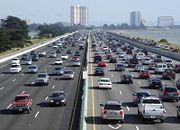- Air Homepage
- Air Quality Testing
- Air Pollution By Cars
Ways to help reduce Air pollution by Cars
Find more about air pollution.
Air pollution by cars needs to be controlled soon. How can we help our environment? North American cars have become less efficient despite growing awareness of global warming and fossil fuel costs.
Of course you are aware that cars can pollute the air? Also, it can be fixed and we can change things! Bigger cars use more gas and pollute the air even more so.
Cars emit stuff like carbon monoxide, which is bad for people and makes our air unhealthy. By driving less and using cleaner cars, we can make air cleaner.
Cities and car companies can help by making cleaner cars and efficient streets. Together, we can keep our air clean and our planet happy!
The popularity of large SUVs has made it use more gas than it did in the late 1980s. What's the connection between air pollution and transportation?
Hopefully not. When engines don't burn their fuel completely, carbon monoxide enters the air.
In North American cities, cars, trucks, and similar vehicles produce 95 percent of the carbon monoxide (CO). Is it dangerous? You bet.
Because this poisonous gas restricts oxygen to the organs and tissues of the body, it irritates people with respiratory illnesses or heart diseases.
The higher levels of CO in the air, the more symptoms people get. Starting with headaches and vision problems, we lose stamina and efficiency at work and other things.
Nitrogen Dioxide and Carbon Dioxide are also emitted by cars. And then there's the noise. You know all about it. It's also considered Air pollution by cars.
Burning Questions
1. What's the deal with cars and air pollution? Facts vs. conjectures
Fact: Cars contribute a lot to air pollution. Transportation, including cars, trucks, and buses, is the biggest source of greenhouse gas emissions in the United States. The combustion of fossil fuels produces harmful emissions, like carbon monoxide, nitrogen oxides, particulate matter, and volatile organic compounds.
However, there's some speculation that cars aren't the main cause of air pollution, there's no scientific evidence for that. Although there are other sources of air pollution, like power plants and industrial activities, cars contribute a lot. Vehicle emissions are a major contributor to poor air quality and associated health problems, according to studies. In order to reduce air pollution from cars, we need to increase fuel efficiency, promote public transportation, and use electric cars more.
2. Are there any effective and cost-efficient ways to reduce car pollution?
It's possible to reduce air pollution from cars while improving public health and the environment by implementing these measures:
- By encouraging fuel-efficient driving habits, such as reducing idling time, maintaining proper tire pressure, and avoiding rapid acceleration and braking, you can significantly reduce emissions and improve fuel economy.
- Changing air filters, spark plugs, and oxygen sensors regularly can improve engine efficiency and cut emissions.
- Reducing the number of cars on the road and reducing emissions by promoting alternative transportation options like public transit, biking, and walking.
- Clean fuels: Switching to cleaner fuels, like biodiesel or renewable natural gas, can reduce emissions.
- Electric vehicle promotion: Incentives, like tax credits and rebates, can reduce emissions and improve air quality.
- Regulators: Implementing government regulations, such as emissions standards and fuel economy regulations, can make cars cleaner.
3. What's the impact of electric cars on air pollution? Does it really have zero emissions?
Electric cars can reduce air pollution a lot more than gasoline-powered cars. Electric cars don't emit tailpipe emissions like gasoline cars, but the production and distribution of electricity used to charge them still emits emissions. Electric cars emit emissions when they charge their batteries. Solar, wind, or hydroelectric power can be considered clean and renewable sources of electricity for electric cars. However, if the electricity comes from fossil fuel plants, then the car will emit emissions.
Even when you take electricity production and distribution into account, electric cars still produce fewer emissions than gasoline-powered cars overall. Electric cars are more energy-efficient because they convert more of their energy into propulsion than gasoline cars, which waste a lot of energy as heat.
Additionally, as renewable energy sources become more prevalent in the grid, electric cars' emissions will drop even more. Electric cars can help mitigate climate change by reducing air pollution and greenhouse gas emissions.
4. What do car manufacturers do to reduce emissions?
Various technologies and techniques are used by car manufacturers to reduce emissions. Some of the most common methods are:
- Car manufacturers reduce emissions by improving engine design and efficiency. Fuel economy and emissions can be improved with turbocharging, direct injection, and variable valve timing.
- Treatment of exhaust gases: Car manufacturers can reduce emissions by treating exhaust gases before they're released. To reduce harmful emissions, you can use catalytic converters and diesel particulate filters.
- A hybrid car reduces emissions and improves fuel efficiency by combining gasoline and electricity. Hybrid cars can reduce emissions by using an electric motor to assist the gasoline engine.
- Manufacturers are also exploring alternative fuel vehicles like electric cars, hydrogen fuel cell cars, and compressed natural gas (CNG) cars. In comparison to gasoline-powered cars, these vehicles produce fewer emissions.
- Lightweight materials: Aluminum and carbon fiber can be used in vehicle construction to reduce emissions. Fuel efficiency can be improved and weight can be reduced.
- Designing cars aerodynamically can reduce drag and improve fuel efficiency, which can reduce emissions.
- Improved transmission: A car's transmission impacts fuel economy and emissions a lot. Manufacturers are improving transmissions by using advanced gear ratios and designing them to shift better.
Using these techniques and technologies, car manufacturers can reduce emissions and improve fuel economy, which helps reduce the environmental impact of cars.
What Can I do about air pollution by cars?
If you own property or facilities with a lot of traffic, you might need air quality dispersion modelling to figure out what happens. To predict the spread of air pollutants from a source, such as a busy highway, factory or power plant, air quality dispersion modelling uses mathematical equations and algorithms. You can use it to figure out how to reduce air pollution and understand its impacts.
Air quality dispersion models can show how pollutants released from a property or facility will disperse in the air. You can also find out if these pollutants pose any health risks in your area, where they go and who they affect? Find out how to get air modeling air modeling done.
What can consumers do to enact an air quality solution regarding our cars? We can all choose to drive less. For those living in cities and towns, a great first step is to begin to walk or bike to nearby destinations.
The environment will thank you, and so will your body, as you'll notice improved health. Why pay for a gym membership and drive there? You can also buy a smaller, more energy-efficient car next time, and drive it more conservatively. Follow the rules of the road. Make sure your tires are inflated and maintained.
Automobile companies could help by designing energy-efficient vehicles and putting good emissions controls in place.
By designing more efficient traffic-flow infrastructure, cities could make a difference. Traffic jams are a big contributor to air pollution. We sit and stew while our cars spew.
The North Americans don't like giving up their rights, but more laws restricting vehicle use may result from air pollution.
There could be more regulations, fines, and permit requirements just to drive, so it won't be our right. Maybe it wasn't. That's why we should start reducing our reliance on cars voluntarily.
Let's talk about inside the car. Filters clean your air supply if you install them right. Also, watch out for that new car smell. That stuff is carcinogenic.
Go back from Air Pollution by Cars to the Air Quality Testers webpage.
Search this site for more information now.
Getting Polluted by Cars: Don't Breathe Deeply!
Air pollution from traffic is a major cause of damage to the environment.
One of the major pollutants emitted by cars is carbon monoxide, but wiser use of vehicles could begin to reverse the trend.
Do you have concerns about air pollution in your area??
Perhaps modelling air pollution will provide the answers to your question.
That is what I do on a full-time basis. Find out if it is necessary for your project.
Have your Say...
on the StuffintheAir facebook page
Other topics listed in these guides:
The Stuff in the Air Site Map
And,
Thank you to my research and writing assistants, ChatGPT and WordTune, as well as Wombo and others for the images.
GPT-4, OpenAI's large-scale language generation model (and others provided by Google and Meta), helped generate this text. As soon as draft language is generated, the author reviews, edits, and revises it to their own liking and is responsible for the content.






New! Comments
Do you like what you see here? Please let us know in the box below.